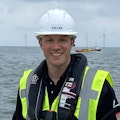AI-powered detection platform deployed on offshore rigs to improve safety
By Doug Lothian, Zelim
Offshore energy operators are beginning to adopt AI-based detection systems to enhance safety and reduce the risk of man overboard (MOB) incidents, and there is a growing industry appetite for using machine learning to support safety and asset monitoring offshore.
Following a successful year-long deployment on a North Sea rig operated by Valaris, Zelim's ZOE intelligent detection and tracking platform has now been installed on a second jackup rig. The technology combines visual hardware with AI software to automatically detect when a person falls overboard and tracks their position in real time. This enables quicker, more accurate emergency response.
The system was built specifically for the maritime environment, which presents unique technical challenges. The first problem in a MOB event is knowing when and where it happened. The second is tracking the person in the water, especially in rough conditions. ZOE provides real-time tracking and geo-location to coordinate a response.
Unlike the technology's first installation, which by and large remained in a fixed location, the new rig relocates frequently and operates in varied sea states, lighting and weather. This requires the system to adapt continuously and still perform reliably.
ZOE’s AI is powered by machine learning models trained on a proprietary dataset developed by Zelim over several years. The company began building this dataset in 2020 during development of the Zelim Guardian unmanned MOB rescue vessel, using drone footage to capture real-world images of people in the water. These images were manually labeled and used to train advanced algorithms. The result is a dataset with more than 7 million annotated images, believed to be the most comprehensive of its kind for maritime search and rescue.
The dataset was critical. People don’t look the same in the water; they may be face down, wearing dark clothing, partly submerged or obscured by spray. The Zelim team had to ensure the system could still detect them accurately.
ZOE also reasons over time. Instead of analyzing a single frame in isolation, it tracks objects across multiple frames, using movement patterns and distance estimation to filter out false positives from seabirds, debris or wave reflections. Range is calculated using lens data and pixel density.
The system integrates with a vessel’s existing surveillance and response infrastructure. Detection and alerting are handled locally via onboard processing, without reliance on remote servers. Training and 24/7 technical support can also be provided to maintain consistent performance.
ZOE’s core AI engine has also been adapted into additional modules. The Watchkeeper module, for instance, supports navigation by acting as an automated lookout, while Shield monitors security zones around offshore assets, alerting crews to unauthorized activity. Both systems build on ZOE’s detection capabilities but serve different operational needs.
If a person in the water can be reliably detected, that same technology can be applied to navigation, perimeter monitoring or general safety watchkeeping. This provides more than detection; it offers situational understanding and asset protection.
Zelim’s technology has also been tested with the US Coast Guard, whose own research found that human spotters may miss targets up to 80% of the time under poor conditions. AI doesn’t blink, doesn’t get tired and doesn’t miss what’s in plain sight. That consistency is vital in safety-critical roles.
As operators look for ways to enhance emergency response and situational awareness, AI systems are becoming part of the standard offshore safety toolkit—not replacing human decision-making but strengthening it.
About the Author

Doug Lothian
Doug Lothian is the co-founder and CTO of Edinburgh-based maritime tech company Zelim. With more than two decades of experience in IT innovation across tightly regulated sectors, including a previous role as a partner at Seven Investment Management, Lothian now spearheads Zelim’s technology vision. He leads the development of its platforms and oversees R&D initiatives. His work has played a central role in Zelim’s partnerships, including joint testing and trials with the US Coast Guard.
